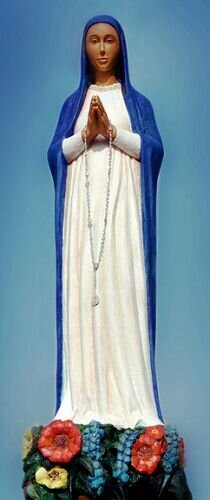Rwanda, Kibeho
Our Lady of Kibeho, Mother of the Word, Mother of God
In the church Our Lady Of Sorrows, Shrine of Our Lady of Kibeho, B.P. 341 Kibeho, Butare, Rwanda, 2003, painted wood, 1.20 m high, by Mark Kowalski of the Academy of Fine Arts in Warsaw.
Although this statue is not officially a Black Madonna, I am including her in this index for two reasons:
Because Stephanie Georgieff, author of: “The Black Madonna: Mysterious Soul Companion”, sent me the first draft of this post with the request to include it.
Because Our Lady of Kibeho sheds a significant ray of light on the issue of Black Madonnas in Africa.
This statue is the attempt to portray the Divine Mother as she appeared to three young visionaries in Kibeho, Rwanda between 1981 and 89 with dire warnings of the impending genocide and instructions on what it would take to avert it.¹ 17 year old Alphonsine Mumreke, the first to see her, reported: “The Virgin was not white, as She is usually seen in holy pictures. I could not determine the color of Her skin, but She was of incomparable beauty.”² In the documentary film “Our Lady of Kibeho” Nathalie Mukamazimpaka, the third visionary, says: “None of the statues of the Virgin Mary that I’ve seen resemble her. I saw her face and it was very beautiful. When you look at her, you see that she has a beauty that transcends that of whites and blacks. Nonetheless, her eyes very closely resemble those of blacks.”
To appreciate the importance of these statements we have to know what the prolific author Immaculée Ilibagiza addresses in her writings: that Jesus and Mary are routinely portrayed as blond and blue eyed in African Catholic literature and art.³ Our Lady of Kibeho acted against this racist message that God incarnate, since he must be beautiful, must be white, blond, and blue eyed. She contradicted this message in a very skillful, subtle way by making her visionaries “color blind” as to the color of her skin. She showed that beauty has nothing to do with the color of your skin but with the amount of your love. As she said in Medjugorje on March 25, 1985, when Jelena Vasilj asked Our Lady why She is so beautiful: "I am beautiful because I love. If you want to be beautiful, love. There is no one in the world who does not desire beauty."⁴
I think the artist did a fairly good job at portraying Mary as neither black nor white, but some kind of unusual mixture of races. The image was created in three phases and models were submitted to Nathalie Mukamazimpaka, the only one of the visionaries still living in Rwanda at the time. She kept rejecting the Rwandan and Polish artists’ attempts at portraying the beauty of the Queen of Heaven. Finally she gave a reluctant blessing to this final version.
When fans of the Black Madonna fall into a reverse kind of racism by appreciating only Black Madonnas while disparaging white ones, they would do well to remember Our Lady of Kibeho. She appeared with a message of reconciliation between ethnic groups, whether tribes of the same color or races of different colors. She expressed this not only by appearing as neither black nor white, but simply as universally beautiful. She also kept appearing in fields of multicolored flowers that she asked to be watered. The visionaries as well as the pilgrims soon came to realize through the messages of the Virgin of Kibeho that the three types of flowers (shown at the base of the statue) represented the people of Rwanda (Hutu, Tutsi, and Twa), all of them children of God and flowers in His Kingdom that need to be nourished with love.⁵
The feast day of Our Lady of Kibeho is November 28, the anniversary of the initial apparition to Alphonsine Mumureke in 1981. For more details visit the shrine’s website: http://www.kibeho-sanctuary.com/en/
Above the shrine
Kibeho church
Footnotes:
1. For a summary of these fascinating apparitions visit https://en.wikipedia.org/wiki/Our_Lady_of_Kibeho For greater details visit the shrine’s website: or better yet, read Immaculée Ilibagiza’s “Our Lady of Kibeho”.
2. “Messages of Our Lady of Sorrows in Kibeho, Rwanda”
3. Immaculée Ilibagiza with Steve Erwin, “Led by Faith: Rising from the Ashes of the Rwandan Genocide”, Hay House, Carlsbad: 2008, p. 113
4. Quoted in the free Medjugorje newsletter.
5. See the website of the shrine, scroll down to The Statue of Our Lady of Kibeho.




